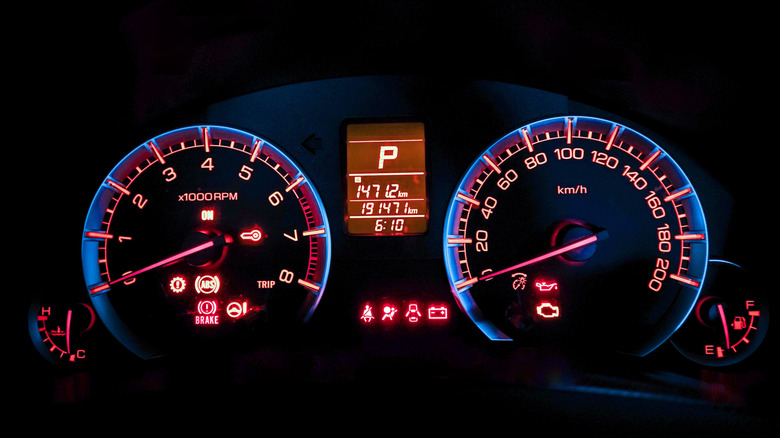
Other than the road, one thing you should also pay attention to while driving is your dashboard. It shows you a lot of information about your car, some to notify you and some to give you a warning. Cars across different manufacturers share many frequently seen dashboard indicators and warning signals So, if you have driven several other vehicles previously, you should have a good understanding of their meanings.
However, what happens if you’re a novice driver who isn’t well-versed in those red, green, and yellow icons? For instance, if your vehicle is a Chevrolet, you may encounter certain dashboard lights and signals. Remember, many of these will appear when you first turn on the engine; this does not necessarily indicate an issue right away. Typically, everything’s fine if they vanish after you begin driving. Yet, if these signs persist even while you drive, knowing how to respond becomes crucial at that point.
Read more: Chevrolet's Top 10 Most Powerful Engines of All Time, Ranked
Engine And Battery Symbols
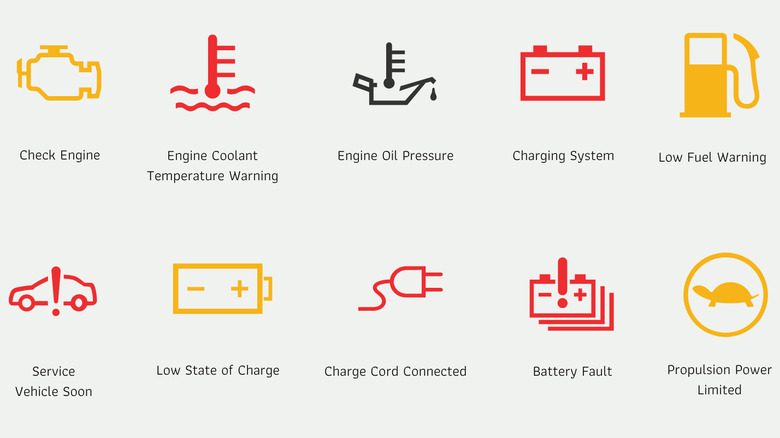
Some of the crucial dashboard alerts and signals to monitor in your Chevrolet pertain primarily to the engine and battery. First among these is the Check Engine light. This indicator illuminates during operation because of problems such as poor-quality fuel, leaving the filler cap open, or malfunctions within the emissions control system, drive train, or engine itself. You should take your vehicle to an authorized repair facility when this happens.
The Engine Coolant Temperature warning illuminates when an engine overheat is detected. Immediately cease operation and turn off the engine. Likewise, should you notice the Engine Oil Pressure indicator illuminated on your dash, pull over safely and power down the vehicle. This sign indicates your system requires attention. The engine oil could be getting low. Refill it to the normal level and restart the vehicle. If the issue persists for over ten seconds, there could be a problem with the oil system; thus, consult your mechanic.
The Charging System indicator illuminates upon detecting a problem within your vehicle’s electrical charging mechanism. Pull over right away to prevent battery discharge and get your automobile inspected promptly. Additionally, you could encounter the Low Fuel Warning signal, which merely signifies that your gas tank is nearly depleted. Refuel to eliminate this alert.
If you own an electric vehicle, consider getting acquainted with these battery and propulsion system-related symbols: 1. Battery Management System (BMS) 2. Electric Motor Symbol 3. Charging Port Icon 4. High-Voltage Warning Sign 5. Regenerative Braking Indicator
- Service Vehicle Shortly: Indicates an issue with the battery, suggesting a potential visit to a service station may be necessary.
- Low Battery Level: Your electric vehicle requires charging due to insufficient power remaining.
- Charging Cable Plugged In: Ensure you unplug your charging cable prior to driving for safety reasons.
- Battery Issue: There is a problem with the high-voltage battery system; therefore, consult a technician.
- Propulsion Power Limited informs you about an issue with your propulsion system, which stops you from utilizing full throttle and velocity. Schedule a servicing session now.
To steer clear of these issues in the future, make sure not to overlook your preventive maintenance schedules.
Braking And Stability Symbols
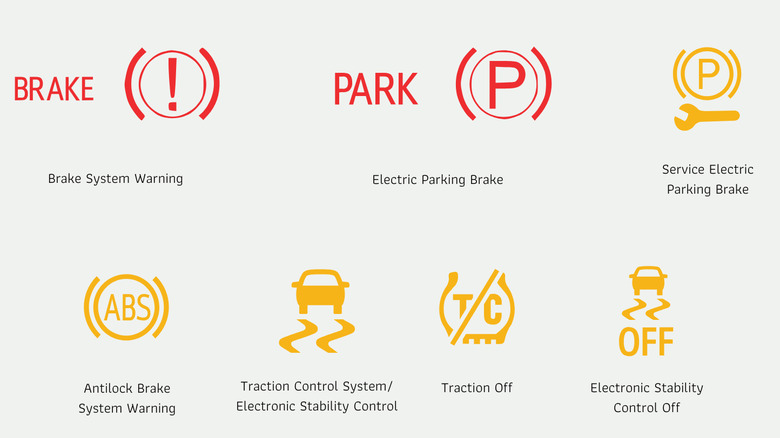
According to the U.S. National Highway Traffic Safety Administration , 22% of vehicle accidents result from issues with the braking system. Therefore, if you notice any warning lights related to the brakes illuminated on your dashboard, the worst action would be to disregard them.
The primary alert you should recognize is the Brake System Warning. This indicates an issue with your braking mechanism; hence, you ought to stop safely as soon as possible. This indicator may also illuminate due to insufficient brake fluid levels. Regardless of the cause, contact a mechanic promptly to inspect your brakes. Conversely, the Electric Parking Brake light should activate solely upon activation by the driver. Should this lamp remain illuminated after releasing the parking brake, it signifies potential malfunctions within the electric parking brake system—indicating a visit to the repair shop is necessary. Similarly, encountering the Service Electric Parking Brake icon signals that service is required specifically for the electric parking brake function. Lastly, the Antilock Brake System (ABS) Warning lights up whenever maintenance is needed for your vehicle’s ABS or if the front axle locking feature engages, typically found in vehicles equipped with four-wheel drive systems.
In addition to monitoring your brakes, it’s crucial to keep tabs on your stability-related dashboard icons. Primarily, there's the Traction Control System (TCS) / Electronic Stability Control (ESC). You might notice this indicator blinking when the TCS, ESC, along with the Anti-lock Braking System (ABS), are operational; however, if it remains illuminated steadily, it suggests potential issues within those systems—seek professional advice from a technician then. The “Traction Off” warning signifies that either the TCS or ESC has been deactivated intentionally, whereas "Stability Control Off" means both have been turned off. Typically, activating these features enhances handling during challenging road conditions such as wet surfaces and sharp turns.
Safety And Security Symbols
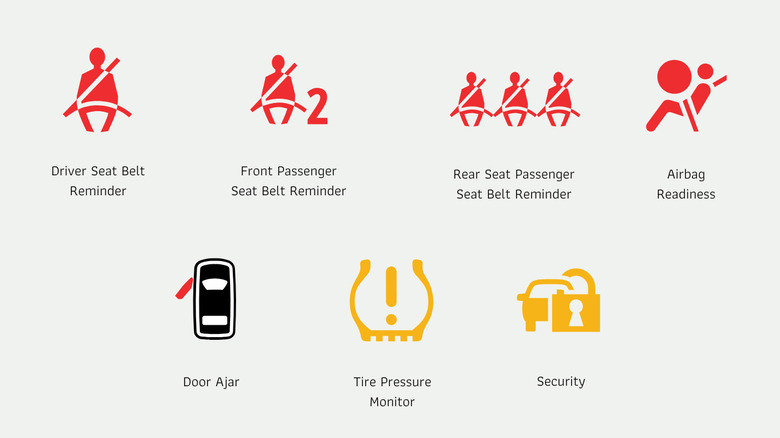
Similar to other vehicles, your Chevrolet comes equipped with safety and security features designed to protect both you and your automobile. Before fastening your seatbelt, you might notice an indicator light on your dashboard. Contemporary models typically display distinct signals for the driver, front-seat passenger, and backseat occupants; however, their purpose remains consistent—to remind everyone inside the vehicle to wear their seat belts securely.
Next, consider the Airbag Readiness indicator. Should this light remain illuminated steadily as you drive, it suggests an electrical problem with your airbag system. This could result in unintended deployment of the airbags or failure to deploy them during a collision. In such cases, take your vehicle to a professional for inspection. Conversely, the Door Ajar warning indicates that one of your doors hasn’t been fully shut. Before proceeding, ensure all doors are securely closed.
When vehicles have the Tire Pressure Monitoring System installed, a warning icon for low tire pressure will appear on your dashboard whenever at least one of your tires falls below the suggested inflation level. Should this indicator remain lit despite all your tires being correctly filled, additional problems could be present. This may include having an absent or non-functioning sensor. Furthermore, using a spare tire without a TPMS sensor, rotating your tires without recalibrating the system, or installing new tires and wheels with differing specifications can cause the TPMS to fail improperly.
Should your vehicle feature a passive theft-deterrence mechanism and the security indicator lights up, this could signal a problem within the system. You may resolve this by turning off the engine and restarting it.
Driver Assistance Symbols
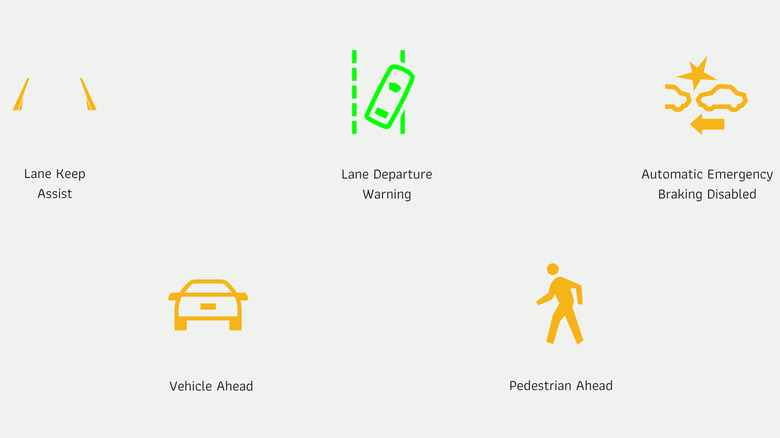
To simplify driving, certain Chevrolet models include various driver aid systems. For example, the Lane Keep Assist displays differently colored indicators on your dashboard once activated. A white light signifies that it’s not yet engaged; a green one means it’s prepared to assist; an orange indicator signals that you’re drifting from your lane without signaling, and the system is intervening to guide you back into position. Additionally, should you inadvertently exit a designated lane without using your turn signal, the system will alert you with an amber warning. This same status can be indicated as green, indicating that the feature is operational.
The Automatic Emergency Braking (AEB) Disabled indicator will appear immediately upon deactivating your AEB system. However, should the icon persist without intentional disablement, this could indicate either a problem with the system itself or external elements such as a grimy windshield or adverse weather conditions (such as rain, snow, or fog), which may hinder its proper operation.
When your vehicle has Forward Collision Alert installed, the dashboard displays a Vehicle Ahead icon; this appears in green when another car is detected ahead of you and switches to amber once it senses that you may be following too closely. Should your model include the Front Pedestrian Braking System as well, an Amber-colored Pedestrian Ahead indicator illuminates whenever your car identifies someone walking or cycling closeby.
Lighting Symbols
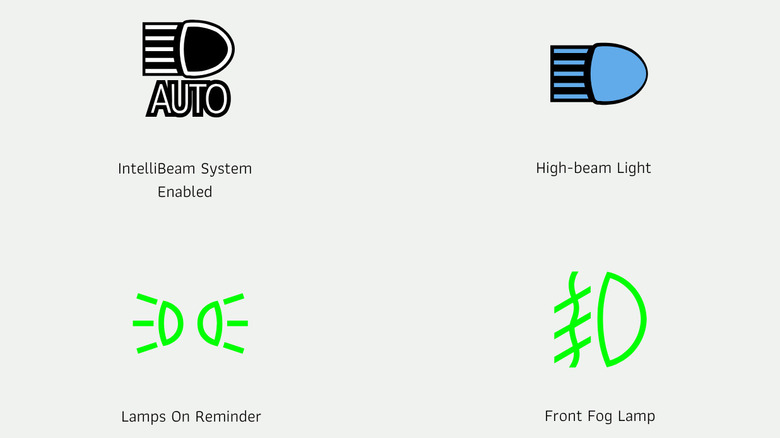
The condition of your vehicle’s lighting might not seem like a major issue, yet it’s beneficial to recognize whether each light is illuminated or dark. It’s important to ensure you haven’t accidentally turned them on since they could quickly deplete your battery. Additionally, during nighttime drives, verify that you possess adequate illumination for better sight without causing glare for approaching vehicles.
The High-Beam Light, Lamps On Reminder, and Front Fog Lamp icons each indicate their respective usage: the High-Beam Light signifies active high beams; the Lamps On Reminder shows that your headlights and taillights are illuminated; and the Front Fog Lamp indicates that both front fog lamps are turned on. Conversely, when the IntelliBeam System Enabled icon appears, it means you have switched on the IntelliBeam feature. If this indicator transitions from green/white to blue, it signals that the environment—being dark with no approaching vehicles—is optimal for activating your high-beams automatically through the IntelliBeam system.
Looking for the newest in technology and automotive developments? Sign up for our complimentary email newsletter. For the most recent news stories, detailed guides, and step-by-step advice, delivered once via email.
Read the original article on solusikaki.com .
